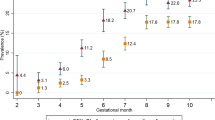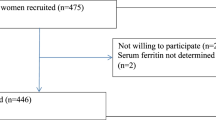Abstract
The study was conducted to investigate determinants (clinical, nutritional, and nonnutritional factors) of anemia among pregnant women in Kassala, eastern Sudan. Sociodemographic characteristics were gathered; serum ferritin, zinc, albumin, and C-reactive protein were measured using different laboratory methods in a cross-sectional study of 250 pregnant women. Of the 250 women, 58.4% had anemia (hemoglobin (HB) <11 g/dl), 6.8% had severe anemia (HB < 7 g/dl), 19.6% had iron deficiency (S-ferritin <15 µg/l), 14.8% had iron deficiency anemia (<11 g/dl and S-ferritin <15 µg/l), and 38% had zinc deficiency (<80 µg/ml). S-albumin, zinc, and ferritin were significantly lower in patients with severe anemia. While age, gestational age, ferritin, and C-reactive protein were not predictors for anemia, primigravidae (OR = 2.7, 95% CI = 1.1–6.7, P = 0.02), low S-albumin (OR = 5.9, 95% CI = 1.4–25.2, P = 0.01), and low S-zinc (OR = 2.6, 95% CI = 1.0–6.6, P = 0.03) were the predictors for anemia. While there was no significant correlation between hemoglobin, S-zinc, and S-ferritin, there was a significant positive correlation between hemoglobin and S-albumin (r = 0.308, P = 0.001) and significant inverse correlation between hemoglobin and C-reactive protein (r = 0.169, P = 0.007). Thus, the role of chronic inflammation and zinc as possible contributing factors to anemia in pregnancy has important implications for the clinical evaluation and treatment of these women.
Similar content being viewed by others
References
World Health Organization (1990) The prevalence of anaemia in women: a tabulation of available information. Geneva: Maternal Health and Safe Motherhood Programme, World Health Organization, p 100
Adam I, Khamis AH, Elbashir MI (2005) Prevalence and risk factors for anaemia in pregnant women of eastern Sudan. Trans R Soc Trop Med Hyg 99:739–743
Stoltzfus RJ, Chwaya HM, Tielsch JM, Schulze KM, Albonico M, Savioli L (1996) Epidemiology of iron deficiency anaemia in Zanzibari schoolchildren: the importance of hookworms. Am J Clin Nutr 65:153–159
Jansson LT, Kling S, Dallman PH (1986) Anaemia in children with acute infection seen in a primary care pediatric outpatient clinic. Pediatr Infect Dis 5:424–427
Fishman SM, Christian P, West KP (2000) The role of vitamins in the prevention and control of anaemia. Public Health Nutr 3:125–150
Dijkhuizen MA, Wieringa FT, West CE, Muherdiyantiningsih M (2001) Concurrent micronutrient deficiencies in lactating mothers and their infants in Indonesia. Am J Clin Nutr 73:786–791
Pathak P, Kapil U, Dwivedi SN, Singh R (2008) Serum zinc levels amongst pregnant women in a rural block of Haryana state, India. Asia Pac J Clin Nutr 17:276–279
Gibson RS, Abebe Y, Stabler S, Allen RH, Westcott JE, Stoecker BJ, Krebs NF, Hambidge KM (2008) Zinc, gravida, infection, and iron, but not vitamin B-12 or folate status, predict hemoglobin during pregnancy in Southern Ethiopia. J Nutr 138:581–586
Adam I, Babiker S, Mohmmed AA, Salih MM, Martin H, Prins MH, Zaki ZM (2008) Low body mass index, anaemia and poor perinatal outcome in a rural hospital in eastern Sudan. J Trop Pediatr 54:202–204
Haggaz AD, Radi EA, Adam I (2010) Anaemia and low birthweight in western Sudan. Trans R Soc Trop Med Hyg 104:234–236
Bushra M, Elhassan EM, Ali NI, Osman E, Bakheit KH, Adam II (2009) Anaemia, zinc and copper deficiencies among pregnant women in central Sudan. Biol Trace Elem Res online
Bukar M, Audu BM, Yahaya UR, Melah GS (2008) Anaemia in pregnancy at booking in Gombe, North-eastern Nigeria. J Obstet Gynaecol 28:775–778
Cook JD, Baynes RD, Skikne BS (1992) Iron deficiency and the measurement of iron status. Nutr Res Rev 5:189–202
Yip R, Dallman PR (1988) The roles of inflammation and iron deficiency as causes of anemia. Am J Clin Nutr 48:1295–1300
Huddle JM, Gibson RS, Cullinan TR (1998) Is zinc a limiting nutrient in the diets of rural pregnant Malawian women? Br J Nutr 79:257–265
Duggan C, MacLeod WB, Krebs NF, Westcott JL, Fawzi WW, Premji ZG, Mwanakasale V, Simon JL, Yeboah-Antwi K, Hamer DH (2005) Plasma zinc concentrations are depressed during the acute phase response in children with falciparum malaria. J Nutr 135:802–807
Koj A (1985) Definition and classification of acute phase proteins. In: Gordon A, Koj A (eds) The acute phase response to injury and infection. Elsevier Science Publishers B.V. (Biomedical Division), Amsterdam, pp 139–144
Volanakis JE (2001) Human C-reactive protein: expression, structure, and function. Mol Immunol 38:189–197
Mahmoud MM, Nasr AM, Gassmelseed DE, Abdalelhafiz MA, Elsheikh MA, Adam I (2007) Knowledge and attitude toward HIV voluntary counseling and testing services among pregnant women attending an antenatal clinic in Sudan. J Med Virol 79:469–473
Gassmelseed DE, Nasr AM, Homeida SM, Elsheikh MA, Adam I (2006) Prevalence of HIV infection among pregnant women of the central Sudan. J Med Virol 78:1269–1270
Acknowledgments
We wish to thank all the patients for their excellent cooperation and we are very grateful to the local health authority in Kassala State and to the entire staff of Kassala Maternity Hospital. We thank Mr. Abdalla Hafazalla for his excellent technical assistance. This work has been supported by The Ministry for Higher Education and Scientific Research, Sudan.
Author information
Authors and Affiliations
Corresponding author
Rights and permissions
About this article
Cite this article
Mohamed, A.A., Ali, A.A.A., Ali, N.I. et al. Zinc, Parity, Infection, and Severe Anemia Among Pregnant Women in Kassla, Eastern Sudan. Biol Trace Elem Res 140, 284–290 (2011). https://doi.org/10.1007/s12011-010-8704-3
Received:
Accepted:
Published:
Issue Date:
DOI: https://doi.org/10.1007/s12011-010-8704-3




